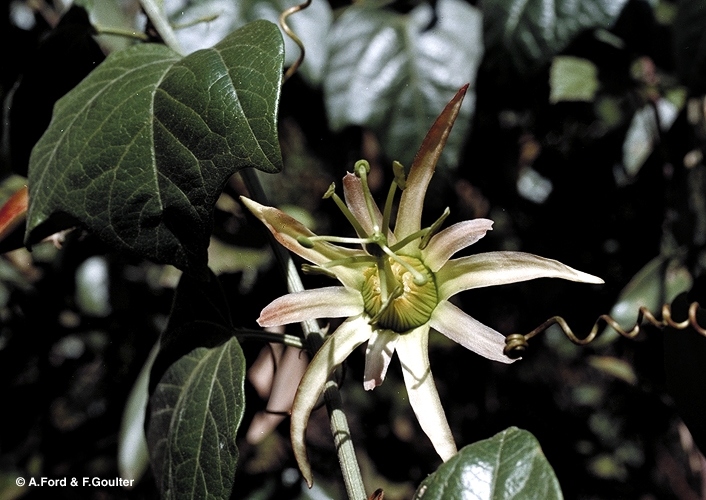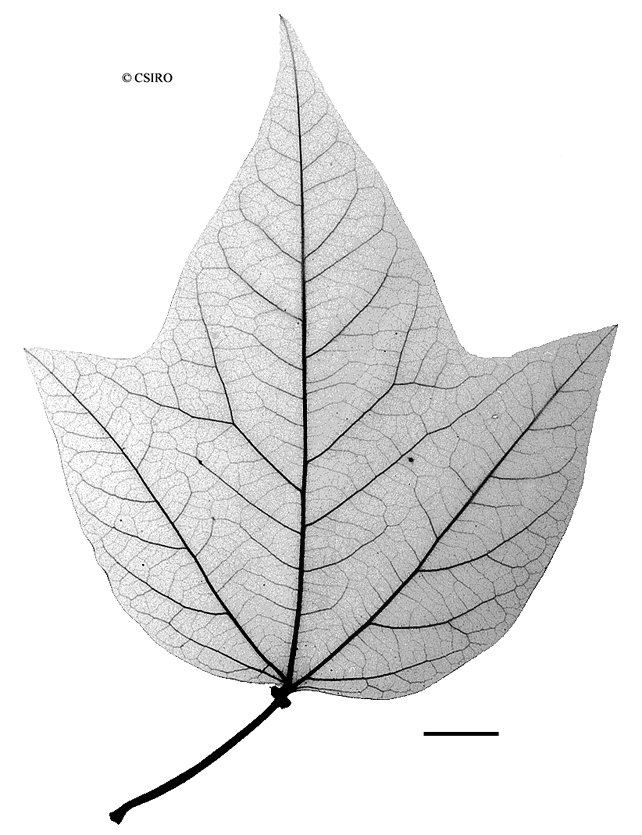Australian Tropical Rainforest Plants - Online edition
Passiflora herbertiana Ker Gawl.






Ker Gawler, J.B. (1823) Edwards' Botanical Register 9 : t. 73. Type: The sample for the drawing ..ex the collection of Highclere, raised from seed gathered in the interior of New Holland, A Cunningham.
Native Passionfruit; Yellow Passion Flower; Native Passion Flower
A slender vine not exceeding a stem diameter of 2 cm.
Leaf blades three-lobed (lobes pointed) blades about 7-11 x 6.5-9.5 cm, petioles about 1.5-3 cm long with globular glands attached to the sides just below its junction with the leaf blade. Lateral veins about 8-12 on each side of the midrib. Both the upper and lower leaf blade surfaces clothed in short soft hairs. Two large glands usually present on the underside of the leaf blade well away from the midrib and major lateral veins. Stipules filiform, about 3-7 mm long. Tendrils simple, axillary.
Flowers about 6-10 cm diam. on a stalk about 1.5-2.5 cm long. Sepals about 3-4.5 cm long. Petals about 2.5-4 cm long. Androphore about 2.5-3 cm long, free staminal filaments about 1.5 cm long. Anthers about 10 mm long. Styles about 10-14 mm long, stigmas +/- globular. Corona fimbriate, filaments about 5-13 mm long. Ovules very numerous.
Fruits obovoid, about 2.5-5 x 1.5-4 cm. Seeds numerous, each seed about 3-3.5 x 2-2.5 mm, apex pointed, sometimes slightly hooked. Seeds immersed in a yellowish green sweet-smelling pulp. Testa surface pitted. Embryo about 1 mm long. Cotyledons orbicular, about 1 mm diam. Radicle shorter or up to 1 mm long, much narrower than the cotyledons.
Cotyledons elliptic, about 8-10 x 5-6 mm. Midrib does not extend to the apex of the cotyledon but is replaced by a complex network of dichotomous branches arising from the midrib and lateral veins. Hypocotyl glabrous. First leaves three-lobed (each lobe mucronate) and three-veined. Third leaf blade much wider than long, apex truncate. At the tenth leaf stage: leaf blade much wider than long, apex truncate and apiculate, base truncate, margin sinuate. Lateral veins 1 or 2 on each side of the midrib. Leaf blade very pale and sparsely clothed in hairs on the underside, upper surface glabrous. Petiole slender, much longer than the leaf blade. Stipules linear-lanceolate, about 1 mm long, fragile and easily broken. Tendrils simple (unbranched) axillary. Seed germination time 57 to 89 days.
This species is suspected of poisoning stock. Everist (1974).
Food plant for the larval stages of the Glasswing Butterfly. Common & Waterhouse (1981).
Sometimes cultivated for the large flowers. Plants can be short lived.





